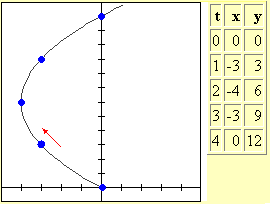|
Think of a curve being traced out over time, sometimes doubling back on itself or crossing itself. Such a curve cannot be described by a function y = f(x). Instead, we will describe our position along the curve at time t by
Then x and y are related to each other through their dependence on the parameter t. Example Suppose we trace out a curve according to
|
||||||||||||||||||||||
Differentiating Parametric Equations
Let x = x(t) and y = y(t). Suppose for the moment that we are able to re-write this as y(t) = f(x(t)). Then dy/dt = [dy/dx]·[dx/dt] by the Chain Rule. Solving for dy/dx and assuming dx/dt ≠ 0,
| dy dx |
= |
|
, |
Example
If x = t2-3 and y = t8, then dx/dt = 2t and dy/dt = 8t7. So
|
= |
|
||||||||||||||||
|
= |
|
-
It is often possible to re-write the parametric equations without the parameter. In the second example, x/3 = cos(t), y/3 = sin(t). Since cos2(t)+sin2(t) = 1, (x/3)2+(y/3)2 = 1. Then x2+y2 = 9, which is the equation of a circle as expected. When you do eliminate the parameter, always check that you have not introduced extraneous portions of the curve.
-
Every curve has infinitely many parametrizations, amounting to different scales for the parameter. For example,
x = 3cos2θ y = 3sin2θ -
Every equation y = f(x) may be re-written in parametric form by letting x = t, y = f(t).
A curve in the xy-plane may be described by a pair of parametric equations
| x = | x(t) | |
| y = | y(t) | , |
The derivative of y with respect to x (in terms of the parameter t) is given by
| dy dx |
= |
dy/dt
dx/dt |







